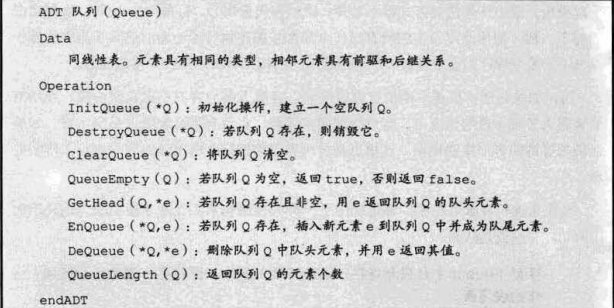
#include "stdio.h" #include "stdlib.h" #include "io.h" #include "math.h" #include "time.h" #define OK 1 #define ERROR 0 #define TRUE 1 #define FALSE 0 #define MAXSIZE 20 /* 存储空间初始分配量 */ typedef int Status; typedef int QElemType; /* QElemType类型根据实际情况而定,这里假设为int */ /* 循环队列的顺序存储结构 */ typedef struct { QElemType data[MAXSIZE]; int front; /* 头指针 */ int rear; /* 尾指针,若队列不空,指向队列尾元素的下一个位置 */ }SqQueue; Status visit(QElemType c) { printf("%d ",c); return OK; } /* 初始化一个空队列Q */ Status InitQueue(SqQueue *Q) { Q->front=0; Q->rear=0; return OK; } /* 将Q清为空队列 */ Status ClearQueue(SqQueue *Q) { Q->front=Q->rear=0; return OK; } /* 若队列Q为空队列,则返回TRUE,否则返回FALSE */ Status QueueEmpty(SqQueue Q) { if(Q.front==Q.rear) /* 队列空的标志 */ return TRUE; else return FALSE; } /* 返回Q的元素个数,也就是队列的当前长度 */ int QueueLength(SqQueue Q) { return (Q.rear-Q.front+MAXSIZE)%MAXSIZE; } /* 若队列不空,则用e返回Q的队头元素,并返回OK,否则返回ERROR */ Status GetHead(SqQueue Q,QElemType *e) { if(Q.front==Q.rear) /* 队列空 */ return ERROR; *e=Q.data[Q.front]; return OK; } /* 若队列未满,则插入元素e为Q新的队尾元素 */ Status EnQueue(SqQueue *Q,QElemType e) { if ((Q->rear+1)%MAXSIZE == Q->front) /* 队列满的判断 */ return ERROR; Q->data[Q->rear]=e; /* 将元素e赋值给队尾 */ Q->rear=(Q->rear+1)%MAXSIZE;/* rear指针向后移一位置, */ /* 若到最后则转到数组头部 */ return OK; } /* 若队列不空,则删除Q中队头元素,用e返回其值 */ Status DeQueue(SqQueue *Q,QElemType *e) { if (Q->front == Q->rear) /* 队列空的判断 */ return ERROR; *e=Q->data[Q->front]; /* 将队头元素赋值给e */ Q->front=(Q->front+1)%MAXSIZE; /* front指针向后移一位置, */ /* 若到最后则转到数组头部 */ return OK; } /* 从队头到队尾依次对队列Q中每个元素输出 */ Status QueueTraverse(SqQueue Q) { int i; i=Q.front; while((i+Q.front)!=Q.rear) { visit(Q.data[i]); i=(i+1)%MAXSIZE; } printf(" "); return OK; } int main() { Status j; int i=0,l; QElemType d; SqQueue Q; InitQueue(&Q); printf("初始化队列后,队列空否?%u(1:空 0:否) ",QueueEmpty(Q)); printf("请输入整型队列元素(不超过%d个),-1为提前结束符: ",MAXSIZE-1); do { /* scanf("%d",&d); */ d=i+100; if(d==-1) break; i++; EnQueue(&Q,d); }while(i<MAXSIZE-1); printf("队列长度为: %d ",QueueLength(Q)); printf("现在队列空否?%u(1:空 0:否) ",QueueEmpty(Q)); printf("连续%d次由队头删除元素,队尾插入元素: ",MAXSIZE); for(l=1;l<=MAXSIZE;l++) { DeQueue(&Q,&d); printf("删除的元素是%d,插入的元素:%d ",d,l+1000); /* scanf("%d",&d); */ d=l+1000; EnQueue(&Q,d); } l=QueueLength(Q); printf("现在队列中的元素为: "); QueueTraverse(Q); printf("共向队尾插入了%d个元素 ",i+MAXSIZE); if(l-2>0) printf("现在由队头删除%d个元素: ",l-2); while(QueueLength(Q)>2) { DeQueue(&Q,&d); printf("删除的元素值为%d ",d); } j=GetHead(Q,&d); if(j) printf("现在队头元素为: %d ",d); ClearQueue(&Q); printf("清空队列后, 队列空否?%u(1:空 0:否) ",QueueEmpty(Q)); return 0; }